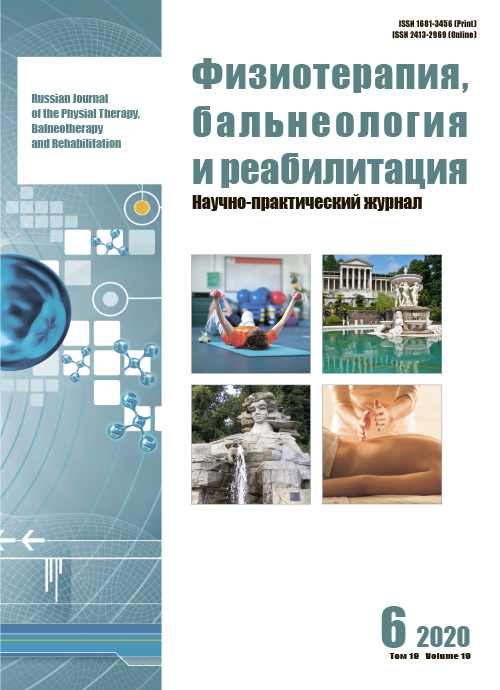Психокорригирующий эффект применения сочетанных методик медицинской реабилитации у пациентов, перенёсших ишемический инсульт
- Авторы: Михайлова А.А.1, Корчажкина Н.Б.1, Конева Е.С.2, Котенко К.В.1
-
Учреждения:
- Российский научный центр хирургии имени академика Б.В. Петровского
- Первый Московский государственный медицинский университет имени И.М. Сеченова Минздрава России (Сеченовский Университет)
- Выпуск: Том 19, № 6 (2020)
- Страницы: 380-383
- Раздел: Оригинальные исследования
- Статья опубликована: 15.12.2020
- URL: https://rjpbr.com/1681-3456/article/view/78552
- DOI: https://doi.org/10.17816/1681-3456-2020-19-6-5
- ID: 78552
Цитировать
Полный текст
Аннотация
Обоснование. Ежегодная смертность от инсульта в России остаётся наиболее высокой в мире.
Цель исследования — изучить влияние сочетанных методик медицинской реабилитации на психологический статус и функциональную независимость больных с постинсультной спастичностью.
Материал и методы. В статье представлены данные по эффективности влияния сочетанных методик медицинской реабилитации на психологический статус и функциональную независимость у 60 больных, перенёсших ишемический инсульт с двигательными нарушениями в виде гемипареза и повышением мышечного тонуса по типу спастичности в отдалённом периоде. Пациенты были разделены на 2 сопоставимые по клинико-функциональным характеристикам группы: основную (n=30), в которой получали сочетанные методы физиотерапии (термотерапию, оксигенотерапию, оксигипертермию, вибротерапию, ароматерапию) от аппарата Alpha LED Оху Light Spa™ в дополнение к стандартному реабилитационному комплексу, включающему лечебную физкультуру, медицинский массаж, кинезиотерапию, и контрольную (n=30), получавшую только стандартный реабилитационный комплекс. Для оценки исходного психологического статуса и функциональной независимости у наблюдаемых пациентов, находящихся на медицинской реабилитации в период от 3 до 6 мес после перенесённого заболевания, использовались методика САН (самочувствие, активность, настроение) и шкала FIM.
Результаты. До начала реабилитации у всех пациентов, включённых в исследование, наблюдались умеренная степень ухудшения самочувствия, снижение активности и настроения, а также снижение показателей независимости в повседневной жизни. После курса лечения (на 14-й день) и в отдалённый период (через 8 мес) у пациентов основной группы наблюдалась выраженная положительная динамика психоэмоционального статуса, что проявлялось улучшением показателей самочувствия в 1,93 раза (на 28%), активности в 1,95 (на 29,6%), настроения в 2,01 (на 29,8%). У больных контрольной группы после стандартного курса лечения отмечалась менее выраженная динамика психометрических показателей. При оценке результатов функциональной независимости по шкале FIM отмечалось достоверное улучшение показателей независимости в повседневной жизни на 32%.
Заключение. Применение сочетанных методик медицинской реабилитации у больных с постинсультной спастичностью способствует значительному повышению их качества жизни и психологического статуса, что подтверждается данными тестов FIM и САН.
Полный текст
Об авторах
Анна Андреевна Михайлова
Российский научный центр хирургии имени академика Б.В. Петровского
Автор, ответственный за переписку.
Email: mikhaylova003@gmail.com
ORCID iD: 0000-0002-4260-1619
SPIN-код: 7673-3241
к.м.н., доцент
Россия, МоскваНаталья Борисовна Корчажкина
Российский научный центр хирургии имени академика Б.В. Петровского
Email: mikhaylova003@gmail.com
ORCID iD: 0000-0001-6913-8778
SPIN-код: 9733-7646
д.м.н., профессор
Россия, МоскваЕлизавета Сергеевна Конева
Первый Московский государственный медицинский университет имени И.М. Сеченова Минздрава России (Сеченовский Университет)
Email: mikhaylova003@gmail.com
ORCID iD: 0000-0002-9859-194X
SPIN-код: 8200-2155
д.м.н., профессор
Россия, МоскваКонстантин Валентинович Котенко
Российский научный центр хирургии имени академика Б.В. Петровского
Email: mikhaylova003@gmail.com
ORCID iD: 0000-0002-6147-5574
SPIN-код: 5993-3323
д.м.н., профессор, чл.-корр. РАН
Россия, МоскваСписок литературы
- Chen Y., Abel K.T., Janecek J.T., et al. Home-based technologies for stroke rehabilitation: A systematic review // Int J Med Inform. 2019. Vol. 123. Р. 1–22. doi: 10.1016/j.ijmedinf.2018.12.001
- Oujamaa L., Relave I., Froger J., et al. Rehabilitation of arm function after stroke. Literature review // Ann Phys Rehabil Med. 2009. Vol. 52, N 3. Р. 269–293. doi: 10.1016/j.rehab.2008.10.003
- Власенко А.В., Михнович В.И., Машанская А.В., и др. Опыт применения селективных электростимулирующих воздействий у детей с двигательными нарушениями // Вопросы курортологии, физиотерапии и лечебной физической культуры. 2017. Т. 94, № 6. С. 22–25. doi: 10.17116/kurort201794622-25
- Liu M., Fujiwara T., Shindo K., et al. Newer challenges to restore hemiparetic upper extremity after stroke: HANDS therapy and BMI neurorehabilitation // Hong Kong Physiotherapy Journal. 2012. Vol. 30, N 2. Р. 83–92. doi: 10.1016/j.hkpj.2012.05.001
- Степанова С.Б. Комплексная реабилитация в условиях отделения по долечиванию больных острыми нарушениями мозгового кровообращения: Автореф. дис. … канд. мед. наук. Екатеринбург, 2009. 29 с.
- Котенко К.В., Епифанов В.А., Епифанов А.В., Корчажкина Н.Б. Реабилитация при заболеваниях и повреждениях нервной системы. Серия «Библиотека врача-специалиста». Москва: ГЭОТАР-Медиа, 2016. 656 с.
- Конева Е.С. Сравнительная оценка эффективности реабилитационных программ у больных с синдромом спастичности: Автореф. дис. … канд. мед. наук. Москва, 2011. 28 с.
- Епифанов А.В., Ачкасов Е.Е., Епифанов В.А., и др. Медицинская реабилитация. Учебное пособие для медицинских училищ и колледжей. Москва: ГЭОТАР-Медиа, 2019. 560 с.
- Иванова Г.Е., Петрова Е.А., Гудкова В.В., и др. Система реабилитации больных с церебральным инсультом в острый период течения заболевания // Сборник лекций и тезисов «Инсульт: мультидисциплинарная проблема». Челябинск, 2008. С. 28–32.
Дополнительные файлы







